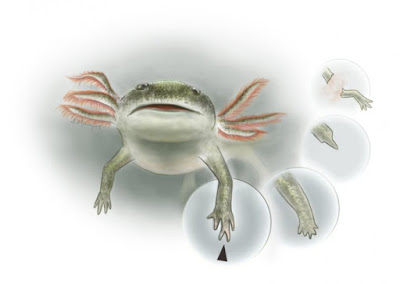
A team of paleontologists of the Museum für Naturkunde Berlin, the State University of New York at Oswego and Brown University shows in a new study of fossil amphibians that the extraordinary regenerative capacities of modern salamanders are likely an ancient feature of four-legged vertebrates that was subsequently lost in the course of evolution.
Salamanders are extraordinary among modern four-legged vertebrates in showing an astonishing capacity to regenerate limbs, tails, and internal organs that were injured or lost due to amputation repeatedly and throughout their entire lifespan. The mechanisms controlling this high regenerative capacity are the focus of a large field of research driven by the hope to some day apply the findings to human medicine.
Salamanders are not only special with respect to their ability to regenerate their limbs, but also in the way their legs develop initially during embryogenesis. Generally limb development follows a highly conservative process in all tetrapods (four-legged vertebrates) — from frogs to humans — despite the enormous variety of forms and functions vertebrate limbs have.
“Salamanders on the contrary form their fingers in a reversed order compared to all other four-legged vertebrates, a phenomenon that has puzzled scientist for over a century” said Dr. Nadia Fröbisch, first author of the study. “The question that we wanted to address was, if and how this different way of developing limbs is evolutionarily linked with the high regenerative capacities.”
The regenerative capacities of salamander tails are likewise remarkable.
“As opposed to lizards, which usually can only regenerate their tails once or twice and merely replace the vertebral column in the tail with a cartilaginous rod, salamanders regenerate a genuine tail including vertebral elements, the neural spine, and associated musculature” said Dr. Constanze Bickelmann, co-author on the study.
Not just salamanders?
Classically the high regenerative capacities of salamanders were considered something special and derived for salamanders. New data from the fossil record offers a new perspective on the evolution of the enormous regenerative capacities of modern salamanders. In their studies the authors investigated different amphibian groups of the Carboniferous and Permian periods (ca. 300 million years ago) and showed that different groups of fossil tetrapods were able to regenerate their legs and tails in a way previously exclusively known from modern salamanders.
“We were able to show salamander-like regenerative capacities in both — fossil groups that develop their limbs like the majority of modern four-legged vertebrates as well in groups with the reversed pattern of limb development seen in modern salamanders,” said Dr. Jennifer Olori of State University of New York at Oswego, co-author on the study.
The fossils used in the study derive from the collections of a number of Natural history museums among them the Museum für Naturkunde Berlin.
“The amphibians fossilized under excellent conditions for preservation and are represented by a large number of individuals and developmental stages” explains Florian Witzmann of Brown University, co-author on the study. “This extraordinary fossil record allowed for the detailed study of limb development and regeneration.”
And that led to important insights about the evolution of the regeneration capacity. Many lineages may have lost it.
“The fossil record shows that the form of limb development of modern salamanders and the high regenerative capacities are not something salamander-specific, but instead were much more wide spread and may even represent the primitive condition for all four-legged vertebrates” says Nadia Fröbisch. “The high regenerative capacities were lost in the evolutionary history of the different tetrapod lineages, at least once, but likely multiple times independently, among them also the lineage leading to mammals.”
The new findings are surprising, the researchers said, and may also be of interest for biomedical studies aiming to unravel the mechanisms responsible for salamander regeneration, as they indicate that not only salamander-specific factors may play a role for the high regenerative capacities, but also mechanisms that all land vertebrates carry within them due to their common evolutionary heritage.
Reference:
Florian Witzmann et al. Deep-time evolution of regeneration and preaxial polarity in tetrapod limb development. Nature, October 2015 DOI: 10.1038/nature15397
Note: The above post is reprinted from materials provided by Brown University.










